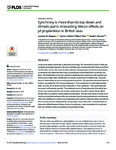Synchrony is more than its top-down and climatic parts: interacting Moran effects on phytoplankton in British seas
| dc.contributor.author | Sheppard, LW | |
| dc.contributor.author | Defriez, EJ | |
| dc.contributor.author | Reid, Philip | |
| dc.contributor.author | Reuman, DC | |
| dc.date.accessioned | 2021-10-14T12:05:15Z | |
| dc.date.issued | 2019-03-28 | |
| dc.identifier.issn | 1553-734X | |
| dc.identifier.issn | 1553-7358 | |
| dc.identifier.other | e1006744 | |
| dc.identifier.uri | http://hdl.handle.net/10026.1/18064 | |
| dc.description.abstract |
Large-scale spatial synchrony is ubiquitous in ecology. We examined 56 years of data representing chlorophyll density in 26 areas in British seas monitored by the Continuous Plankton Recorder survey. We used wavelet methods to disaggregate synchronous fluctuations by timescale and determine that drivers of synchrony include both biotic and abiotic variables. We tested these drivers for statistical significance by comparison with spatially synchronous surrogate data. Identification of causes of synchrony is distinct from, and goes beyond, determining drivers of local population dynamics. We generated timescale-specific models, accounting for 61% of long-timescale (> 4yrs) synchrony in a chlorophyll density index, but only 3% of observed short-timescale (< 4yrs) synchrony. Thus synchrony and its causes are timescale-specific. The dominant source of long-timescale chlorophyll synchrony was closely related to sea surface temperature, through a climatic Moran effect, though likely via complex oceanographic mechanisms. The top-down action of Calanus finmarchicus predation enhances this environmental synchronising mechanism and interacts with it non-additively to produce more long-timescale synchrony than top-down and climatic drivers would produce independently. Our principal result is therefore a demonstration of interaction effects between Moran drivers of synchrony, a new mechanism for synchrony that may influence many ecosystems at large spatial scales. | |
| dc.format.extent | e1006744-e1006744 | |
| dc.format.medium | Electronic-eCollection | |
| dc.language | en | |
| dc.language.iso | en | |
| dc.publisher | Public Library of Science | |
| dc.subject | Chlorophyll | |
| dc.subject | Climate | |
| dc.subject | Ecosystem | |
| dc.subject | Oceans and Seas | |
| dc.subject | Phytoplankton | |
| dc.title | Synchrony is more than its top-down and climatic parts: interacting Moran effects on phytoplankton in British seas | |
| dc.type | journal-article | |
| dc.type | Journal Article | |
| dc.type | Research Support, Non-U.S. Gov't | |
| dc.type | Research Support, U.S. Gov't, Non-P.H.S. | |
| plymouth.author-url | https://www.webofscience.com/api/gateway?GWVersion=2&SrcApp=PARTNER_APP&SrcAuth=LinksAMR&KeyUT=WOS:000463877900020&DestLinkType=FullRecord&DestApp=ALL_WOS&UsrCustomerID=11bb513d99f797142bcfeffcc58ea008 | |
| plymouth.issue | 3 | |
| plymouth.volume | 15 | |
| plymouth.publication-status | Published online | |
| plymouth.journal | PLoS Computational Biology | |
| dc.identifier.doi | 10.1371/journal.pcbi.1006744 | |
| plymouth.organisational-group | /Plymouth | |
| plymouth.organisational-group | /Plymouth/Faculty of Science and Engineering | |
| plymouth.organisational-group | /Plymouth/Faculty of Science and Engineering/School of Biological and Marine Sciences | |
| plymouth.organisational-group | /Plymouth/REF 2021 Researchers by UoA | |
| plymouth.organisational-group | /Plymouth/REF 2021 Researchers by UoA/UoA07 Earth Systems and Environmental Sciences | |
| plymouth.organisational-group | /Plymouth/Users by role | |
| plymouth.organisational-group | /Plymouth/Users by role/Academics | |
| dc.publisher.place | United States | |
| dcterms.dateAccepted | 2018-12-24 | |
| dc.rights.embargodate | 2021-10-15 | |
| dc.identifier.eissn | 1553-7358 | |
| dc.rights.embargoperiod | Not known | |
| rioxxterms.versionofrecord | 10.1371/journal.pcbi.1006744 | |
| rioxxterms.licenseref.uri | http://www.rioxx.net/licenses/all-rights-reserved | |
| rioxxterms.licenseref.startdate | 2019-03-28 | |
| rioxxterms.type | Journal Article/Review |


